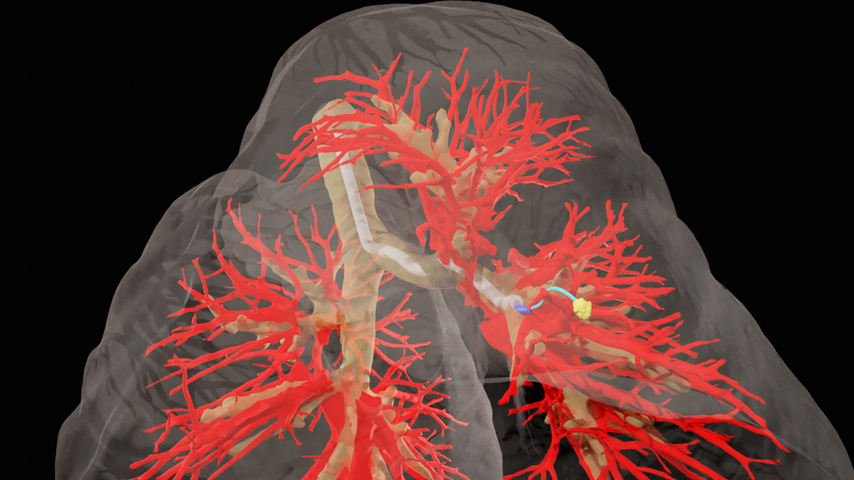Self-Steering Robotic Needle for More Accurate Lung Biopsies
Self-Steering Robotic Needle for More Accurate Lung Biopsies


A flexible self-steering robotic needle can access and retrieve hard-to-reach lung tissue in vivo, which could be game-changing for treatment of lung cancer.
Lung cancer’s toll is steep. In the U.S. alone, more people die of the disease than from colorectal, breast, and prostate cancer combined, according to the American Cancer Society. Physicians can increase the likelihood of survival with early diagnosis using tools that make it easier to assess suspicious lung nodules.
A group of researchers led by principal investigator Ron Alterovitz at the University of North Carolina at Chapel Hill has developed and demonstrated such a tool in live pig tissue (pig lungs are very similar to human lungs). Taking the form of a self-driving needle under human supervision, this robotic system could make lung biopsies easier and safer.
The researchers presented their findings in a paper in Science Robotics. Especially noteworthy is that the team was able to achieve higher accuracies and higher precision with the autonomous robotic device versus the more conventional human-driven equivalent, Alterovitz said. There might be situations where, based on the difficulty of the task, it might be wiser to have the robot perform the procedure autonomously.
When a CT scan of a lung shows suspicious nodules, a physician will use a bronchoscopy procedure to retrieve a sample of the patient’s tissue for biopsy. First, a bronchoscope is navigated through a patient’s mouth and airways, then a straight bronchoscopy needle is used to extract a small portion of tissue.
Using a straight needle is difficult when trying to access tissue in hard-to-reach areas. The other challenge is ensuring safety, Alterovitz continued. The needle must avoid puncturing large blood vessels, which could lead to internal hemorrhaging. “With straight needles you might not be able to reach the site you want in a safe way,” he said.
Discover the Benefits of ASME Membership
Carrying out a biopsy with a needle is also difficult because it involves a kind of advance planning that’s not always intuitive.
“We are navigating through a cluttered anatomical environment in 3D with a device that has a limited turning radius, so you have to figure out in advance where to turn and how to reach a target, which is not easy to do,” Alterovitz said. “The needle is a special type of steerable needle that has a specifically designed tip that when you push it into soft tissue, it starts to curve—then the robot can change the orientation of that tip to change the direction of steering so the needle can follow the planned trajectory.”
How it works
The UNC team’s steerable needle can more deftly avoid anatomical obstacles and enable minimally invasive procedures. Its hardware components include a flexible needle that can curve and a device that can control actuation.
Ideally, the needle must be somewhat “torsionally stiff” for control at the tip, but it also must be flexible enough so that it can be steered through tissue. Nitinol has these properties, while laser etching patterns on the needle surface further optimizes its steerability in lung tissue, Alterovitz explained.
Three different kinds of software are integral to the self-steering needle system.
You Might Also Enjoy: Graphene-based Biosensor Offers Instant Diagnosis
To help the autonomous robotic system understand the environment inside the body, a CT scan of the lung helps the researchers create a map of the region. Then, an AI-driven medical analysis software system evaluates and categorizes the images into anatomical structures so the system can recognize what it’s seeing: the boundary of the lung, an airway, a blood vessel, and parenchymal (lung tissue). “It’s almost like a Google Maps of the inside of the body,” Alterovitz said.
Motion-planning software considers the target, obstacles such as significant blood vessels, and factors in the turning radius and other constraints of the needle to find a safe path to the target. In addition, robotic control software ensures that the needle follows the planned trajectory based on real-time sensor feedback.
For now, the research team has achieved a significant milestone by showing that the robotic steerable needle works in vivo and can navigate around obstacles to reach specified targets. Next steps will involve human trials and exploring implementation with new procedures.
“We’re speaking with physicians about other procedures where autonomous medical robots could improve patient care,” Alterovitz added.
Poornima Apte is technology writer based in Walpole, Mass.



